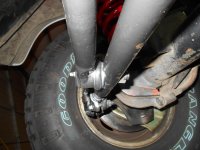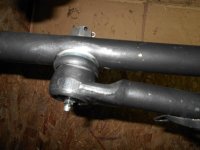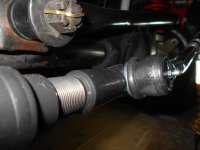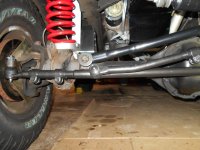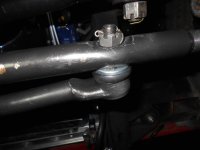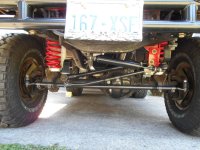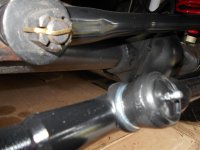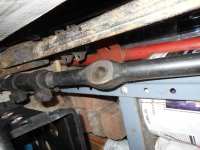Nice quick work! Does roll less for sure. I'd keep it in that more upward position.
And is it my imagination, or is the trackbar bracket flexing visibly in the vid? It's hard to say (because the frame is moving), but going just by the clue of the frame moving, it would seem to be the bracket flexing on the frame. Hence the necessity of welding it eventually.
Glad you'll be having that done at some point. In the meantime, you could mount the camera to the frame and point it at the bracket to see which part is moving and how much.
Don't know if you can find an easy way to mount the camera, but if not it's no big deal. We know they should be welded anyway. Hopefully you'll notice the difference in driving it afterwards.
Regarding the washer, it seems to me that a thin washer (not the included one, whichi s just too thick for that side) should be fitted to the tie-rod side to add that surface area and spread out so there are no edges for the seal to roll over on.
Or reduce the amount that the seal is being compressed by leaving the thick washer out altogether. Doing that would lessen the pressure on the seal and perhaps make spreading the load an unnecessary thing.
Either way though, there should be something to encompass the rod end itself to better seal the ball and socket. Which is the point of this part in the first place.
So if the washer is cupped, try turning it around and running it back on the rod end side. If it's not cupped, leave it off.
Most of the washers I've seen in all brands of replacement tie-rods have been flat, but the very earliest ones I remember had cupped washers only, but most had both.
Some of the cupped washers were large enough to cup the metal rod end, while others were smaller and had to be installed cupped-end towards the bushing/seal.
Still others were too small to fit around the base of the stud at all, and therefore could not be fitted except against the tie-rod, which didn't really make sense at the time because there was no obvious need for a washer against the stock tie-rod.
So if yours is cupped I would flip it so that the cup wraps around the rod end where you can see in the pics there is an un-painted surface. If it's too small to wrap around the casting, then I'm back to just leaving it completely out to see what the seal does by itself.
I've run draglinks without a washer before with no obvious ill effects.
Obviously the bottom line is you want it to seal the joint and last more than a few months. Anything towards that end would be a workable solution to my way of thinking. Meaning that even if the kit includes a washer, if it's better to leave it out then it should be left out.
It's just too thick to be just a spacer on the bushing and would only be used to take up extra space if needed. Which yours does not seem to need.
Paul











